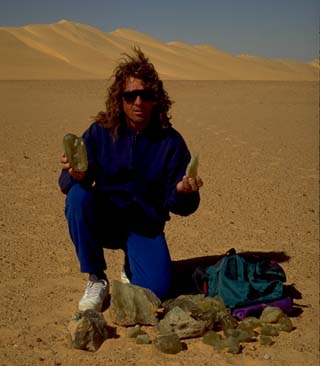 |
Imagine thousands
of square miles of pristine, undulating sand dunes towering 600 feet above
the desert floor, dwarfing your Land Rover, threatening your puny human
existence. These dunes are 300,000 years old. They have slipped and twisted
over the desert for millennia before the first Egyptians built the smallest
mud and wattle huts, let alone the pyramids. And for all that time the
dunes have hidden secrets and treasures along their sinuous flanks, like
precious stones sewn into the hems of twirling, gypsy scarves. Leave it
to Robert Haag to lift the veils for a peek beneath.
We flew into Cairo and from there set out by road to Farafra, the
last oasis. Beyond Farafra stretched something out of a movie set. We spent
12 days in the desert, 1000 kilometers beyond the last known road, navigating
by satellite, like sailors on a great, sand sea. The
|
dunes ran in straight lines for hundreds
of miles -wave after wave of snaking lines of sand. In the valleys and
troughs between, we found the meteorites.
Meteorites, naturally, were why I was there in the first place, thousands
of miles from home and a thousand kilometers from the end of the middle
of nowhere. As on many other trips to obscure and remote places of the
globe, I was looking for anything forwarded from an outer-space address,
but on this trip, we were specifically hunting Libyan desert glass, a particularly lovely variety of tektite.
Libyan desert glass, 29 million years ago was probably formed when
an asteroid or comet hit the surface of the earth like a huge atomic bomb,
unleashing enough destructive force to not only liquefy the rocks, sand
and dirt at ground zero,
|
but to splash the molten, mixed material
up into the wispy outer atmospheric regions. Perhaps some escaped Earth's
gravity altogether; the rest plummeted back in a rain of fire and molten
glass. The crater marking the original impact site has not been discovered
- no doubt it is under millions of pounds of sand. But wherever the original
impact responsible for Libyan Desert Glass occurred, the results came to
rest in the wilds of the Western Egyptian desert.
I had been invited on this expedition by my friend and fellow meteorite
collector, Alain Canon and his son, Louis, who are French. Other members
of the group included Michelle and Olivier, two free-lance writers, and
Didier, a noted mineralogist and adventurer. Sam and Walli were our drivers
and guides. Between them they've logged over a million miles of treacherous sand dune driving. And I mean treacherous. You've never seen any-
|
thing like it. Out there, death sits on your
shoulder like a vulture - one insignificant little accident and you're
just... dead. I found out quickly that surviving the desert is in the details.
We were riding in two, 4-wheel drive turbo diesel trucks. All the fuel,
all the water, all the food, all the spare parts we were possibly going
to need, all had to come along with us, because if we got into trouble,
we couldn't just call MA to come and tow us into town. In fact, if you
get in trouble out there, you're probably in the worst trouble of your
life. We were carrying 150 gallons of fuel per vehicle, and 150 gallons
of water, and I didn't think it would be enough.
Page 2
Home
|
